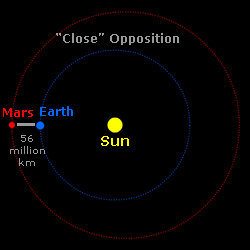Mercury (the dark circle) near the edge of the Sun during the transit.
Click on image for full size
Image courtesy of The Royal Swedish Academy of Sciences.
Mercury Transit on May 7, 2003
News story originally written on July 2, 2003
The planet Mercury crossed in
front of the Sun on May 7, 2003. When that happens,
astronomers call it a transit. A transit is like a solar
eclipse. An eclipse happens when the Moon passes in front of the Sun. A
transit happens when a planet passes in front of the Sun. Planets are much
further away than the Moon, so they look much smaller. A planet does not completely
cover the Sun during a transit like the Moon
does during an eclipse.
There
will be 14 transits of Mercury this century. This one was the first. The last
transit of Mercury before this one was in 1999. The next will
be on November 8, 2006.
Only two planets ever transit the Sun. The two planets
are Mercury and Venus.
Transits of Venus are very rare. They only happen about two times every 100
years! In the 1700's astronomers used
transits of Venus to make the first good measurement of the distance between
Earth and the Sun.
You might also be interested in:

"Transit" is a special term astronomers use. A transit is like an eclipse of the Sun. When an eclipse of the Sun happens, the Moon gets between us and the Sun and blocks the sunlight. When a transit happens,
...more
The planet Mercury will cross in front of the Sun on Wednesday, November 8, 2006. When that happens, astronomers call it a transit. A transit is like a solar eclipse. An eclipse happens when the Moon passes
...more
Here you will find links to all sorts of pictures, animations, videos, sounds, and interactive multimedia that are on Windows to the Universe Explore collections of images in the Image Galleries. Watch
...more
Astronomers have discovered twelve new moons of Jupiter so far this year. Jupiter is the largest planet in our Solar System. It has more moons than any other planet. Jupiter has 52 moons that we know about.
...more
On August 27, 2003, Earth and Mars will be very close together. Well, close for planets anyways. The two planets will still be almost 56 million kilometers (about 35 million miles) apart. They will be
...more
Astronomers have discovered nine new moons. The astronomers found eight new moons of Jupiter and one new moon of Saturn. Jupiter has 60 moons that we know about. Saturn has 31. All of the new moons are
...more
The planet Mercury crossed in front of the Sun on May 7, 2003. When that happens, astronomers call it a transit. A transit is like a solar eclipse. An eclipse happens when the Moon passes in front of the
...more
Did you know that the Sun has spots? Right now it has some very big spots. There are two groups of sunspots on the Sun right now. Each group is about as big as the planet Jupiter, which is the largest
...more












